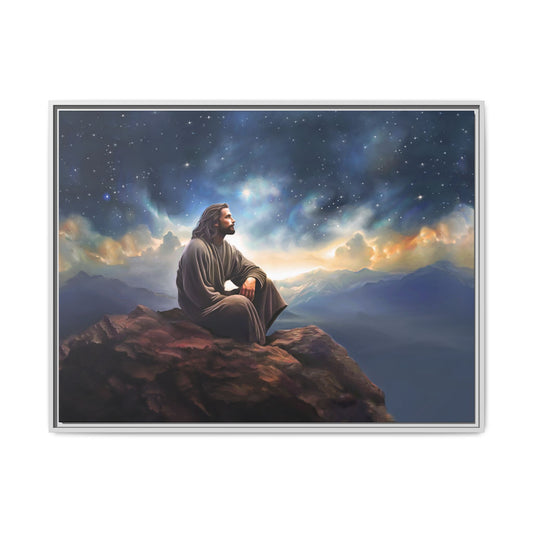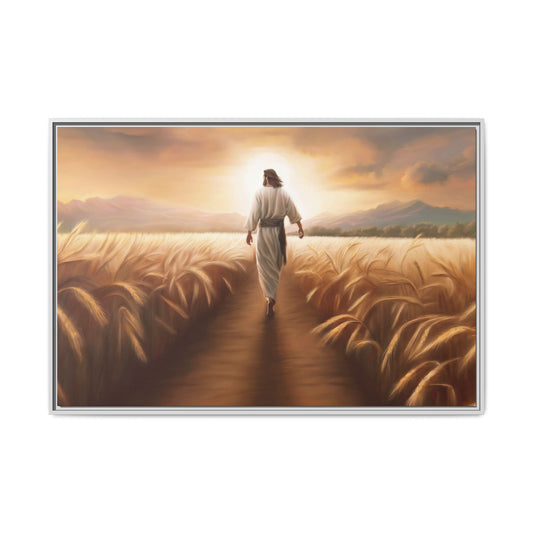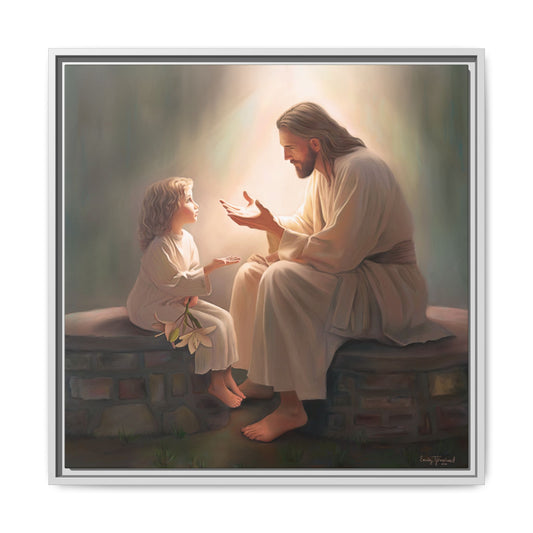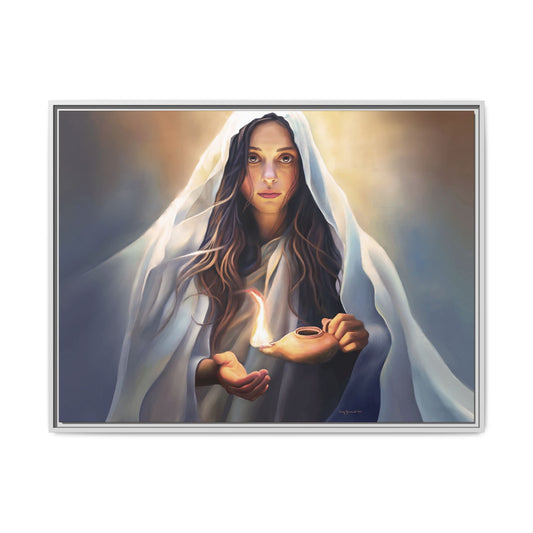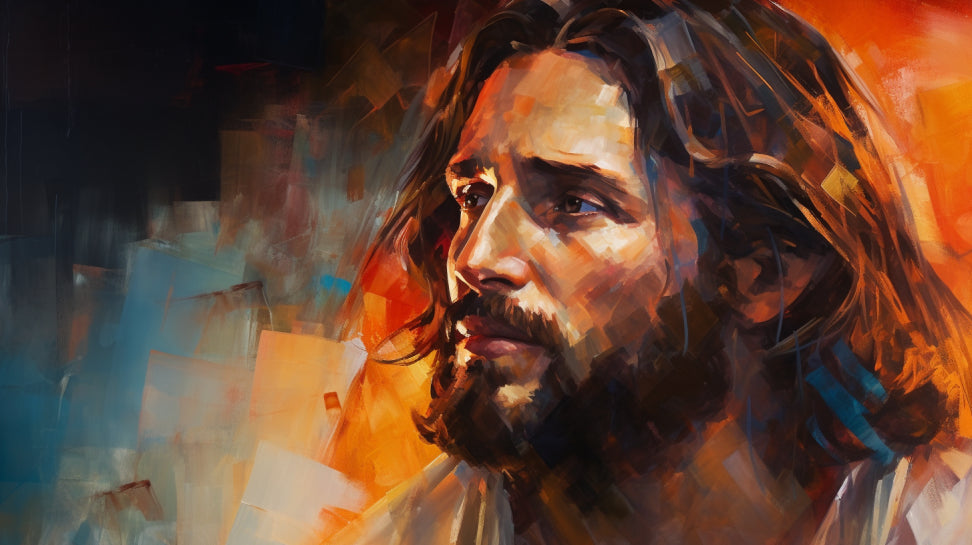
Realistic Jesus Depiction Artwork
Share
For centuries, artists have sought to accurately capture the physical image of Jesus Christ. From the earliest representations of the Son of God to modern attempts to portray him realistically, Jesus depictions have evolved over time. This article will explore the history, controversies, and symbolism of realistic Jesus portraits. We'll look at the quest for an accurate portrayal of Jesus, the various depictions throughout history, and the role of these depictions today. Join us as we take an in-depth look at the significance and challenges of realistic Jesus depictions!
Luke 2:52: 'And Jesus grew in wisdom and stature, and in favor with God and man.' This verse reminds us of Jesus's humanity, His development, and His balanced growth in both spiritual and physical realms, suggesting a depiction that embodies wisdom and divine favor. Mark 6:3: '"Isn’t this the carpenter? Isn’t this Mary’s son and the brother of James, Joseph, Judas, and Simon? Aren’t his sisters here with us?" And they took offense at him.' Reflecting on Jesus's background as a carpenter and His ordinary life in Nazareth offers a dimension of realism, portraying Him as a figure rooted in the realities of working-class life. Matthew 4:23: 'Jesus went throughout Galilee, teaching in their synagogues, proclaiming the good news of the kingdom, and healing every disease and sickness among the people.' Highlighting Jesus's role as a teacher, healer, and proclaimer of the kingdom invites depictions focused on His compassion, authority, and the transformative impact of His ministry. Isaiah 53:3 (Prophetic of Jesus): 'He was despised and rejected by mankind, a man of suffering, and familiar with pain. Like one from whom people hide their faces he was despised, and we held him in low esteem.' This prophecy underscores the suffering and rejection Jesus faced, suggesting depictions that capture the depth of His sacrifice and the humanity of His experience. John 13:4-5: 'So he got up from the meal, took off his outer clothing, and wrapped a towel around his waist. After that, he poured water into a basin and began to wash his disciples’ feet, drying them with the towel that was wrapped around him.' This act of humility and service by Jesus highlights His servant leadership, suggesting depictions that emphasize His humility and the love He showed to others. Matthew 14:14: 'When Jesus landed and saw a large crowd, he had compassion on them and healed their sick.' Jesus's compassion in action, particularly in His response to the suffering of others, calls for depictions that capture the depth of His empathy and His miraculous power to heal and comfort. Hebrews 4:15: 'For we do not have a high priest who is unable to empathize with our weaknesses, but we have one who has been tempted in every way, just as we are—yet he did not sin.' This verse reminds us of Jesus's unique capacity to fully understand human frailty and temptation without succumbing, offering a nuanced portrayal of His sinless nature amidst the human condition. These scriptural references guide us toward understanding and visualizing Jesus in a way that honors His divinity and humanity. They encourage a portrayal that captures the essence of His teachings, His compassion, and the profound impact of His life and ministry. Scriptures can provide a foundation for depicting Jesus in a manner that reflects the reality of His earthly life and the depth of His spiritual mission, offering a multifaceted perspective that can enrich the portrayal of Jesus in art and contemplation.








 We have seen numerous paintings and sculptures of Jesus throughout history. From white marble statues portraying a divine figure to images of Jesus as a young man, artists have depicted him in a variety of ways. These representations often reflect a specific culture, religion, or era. Overview of Famous Paintings and Sculptures:
We have seen numerous paintings and sculptures of Jesus throughout history. From white marble statues portraying a divine figure to images of Jesus as a young man, artists have depicted him in a variety of ways. These representations often reflect a specific culture, religion, or era. Overview of Famous Paintings and Sculptures:








Key Takeaways
- The New Testament Gospels do not provide any description of Jesus' appearance, leading to speculation and imagination about what he may have looked like.
- Early depictions of Jesus in Roman catacombs portrayed him as a beardless shepherd, but by the fourth century, he was commonly depicted with a beard.
- Fictional depictions of Jesus in books like 'The Da Vinci Code' does not provide a clear answer to what Jesus actually looked like.
- Historical and contextual factors suggest that Jesus was likely single and celibate, similar to his cousin John the Baptist and the apostle Paul.

How the Scriptures Help us Envision Jesus
We look to the scriptures to help us balance seeking historical authenticity and recognizing the spiritual and symbolic importance of Jesus's portrayals. While the Gospels do not provide a detailed physical description of Jesus, they offer rich insights into His actions, teachings, and the qualities He embodied. These scriptural passages can inspire artists and believers alike to consider how Jesus's essence and ministry can be depicted in a manner that resonates with authenticity and reverence. These scriptures provide a deeper understanding of His life and mission, offering a framework for depicting Jesus in a way that transcends traditional imagery:Luke 2:52: 'And Jesus grew in wisdom and stature, and in favor with God and man.' This verse reminds us of Jesus's humanity, His development, and His balanced growth in both spiritual and physical realms, suggesting a depiction that embodies wisdom and divine favor. Mark 6:3: '"Isn’t this the carpenter? Isn’t this Mary’s son and the brother of James, Joseph, Judas, and Simon? Aren’t his sisters here with us?" And they took offense at him.' Reflecting on Jesus's background as a carpenter and His ordinary life in Nazareth offers a dimension of realism, portraying Him as a figure rooted in the realities of working-class life. Matthew 4:23: 'Jesus went throughout Galilee, teaching in their synagogues, proclaiming the good news of the kingdom, and healing every disease and sickness among the people.' Highlighting Jesus's role as a teacher, healer, and proclaimer of the kingdom invites depictions focused on His compassion, authority, and the transformative impact of His ministry. Isaiah 53:3 (Prophetic of Jesus): 'He was despised and rejected by mankind, a man of suffering, and familiar with pain. Like one from whom people hide their faces he was despised, and we held him in low esteem.' This prophecy underscores the suffering and rejection Jesus faced, suggesting depictions that capture the depth of His sacrifice and the humanity of His experience. John 13:4-5: 'So he got up from the meal, took off his outer clothing, and wrapped a towel around his waist. After that, he poured water into a basin and began to wash his disciples’ feet, drying them with the towel that was wrapped around him.' This act of humility and service by Jesus highlights His servant leadership, suggesting depictions that emphasize His humility and the love He showed to others. Matthew 14:14: 'When Jesus landed and saw a large crowd, he had compassion on them and healed their sick.' Jesus's compassion in action, particularly in His response to the suffering of others, calls for depictions that capture the depth of His empathy and His miraculous power to heal and comfort. Hebrews 4:15: 'For we do not have a high priest who is unable to empathize with our weaknesses, but we have one who has been tempted in every way, just as we are—yet he did not sin.' This verse reminds us of Jesus's unique capacity to fully understand human frailty and temptation without succumbing, offering a nuanced portrayal of His sinless nature amidst the human condition. These scriptural references guide us toward understanding and visualizing Jesus in a way that honors His divinity and humanity. They encourage a portrayal that captures the essence of His teachings, His compassion, and the profound impact of His life and ministry. Scriptures can provide a foundation for depicting Jesus in a manner that reflects the reality of His earthly life and the depth of His spiritual mission, offering a multifaceted perspective that can enrich the portrayal of Jesus in art and contemplation.
The fascination with Jesus portraits
Why have we been so fascinated with realistic depictions of Jesus over time? There is something captivating about viewing an image of him that is historically accurate. From the early Roman catacombs, to the Byzantine period, to the Reformation and beyond, different cultures have sought to create depictions of Jesus. We seek to understand his physical features, which are absent from the canonical gospels, and to connect with him emotionally through art. Symbolic representations such as the Good Shepherd have been used to convey his teachings and actions, while other works have sought to create more realistic depictions. The fascination with Jesus portraits continues today, as we explore and innovate ways to represent him. We seek to capture his essence and to create a visual representation of his life and teachings. Through art, we also strive to capture the humanity of Jesus and to create a historically accurate picture of him.
The search for a realistic depiction of Jesus Christ
Building on the fascination with Jesus portraits, we have sought to find a realistic depiction of Jesus Christ that captures his essence and humanity. Fictional depictions of Jesus have also been used to explore his appearances, though none provide a definitive answer. We seek to create a realistic depiction of Jesus, informed by the knowledge of the New Testament, early Christian art, and modern interpretations. Our goal is to capture Jesus' humanity and convey his influence and power while avoiding idolatry. Christianity's long history and influence have shaped our search for an accurate depiction of Jesus. This article aims to provide helpful information on the quest for a realistic image of Jesus, including the New Testament's lack of physical description, Jesus' family relationships, early artistic depictions, fictional accounts, and the historical context of Jesus' culture.
The fascination with real Jesus portraits throughout history
We have long been fascinated by the idea of a realistic portrayal of Jesus. Throughout history, there has been a persistent effort to capture the physical features of Jesus with accuracy and realism. This fascination has manifested in various forms, including visual artwork, literature, and film.- Real Picture of Jesus Christ: Depictions of Jesus in early Christian art were more varied before the standardized form emerged. Images of Jesus in art have evolved over time, influenced by cultural and artistic trends.
- Jesus Christ Accurate Picture: The earliest representations of Jesus are found in the Roman catacombs. By the fourth century, Jesus was depicted with a beard, which is the more familiar image seen today.
- Historical Jesus Picture: Beliefs in historically authentic or authoritative images of Jesus remain powerful among some Christian denominations. The Shroud of Turin, Image of Edessa, and Veil of Veronica are examples of relics of that many have become enamored with.

Examining the challenges in creating a faithful representation
Building on our fascination with realistic Jesus portraits, we now explore the challenges of accurately depicting Jesus in artwork. An artist must consider a number of factors when creating a faithful representation of Jesus. Long-standing opposition to depicting Jesus has led to a reluctance to create realistic images of him. Ethnic characteristics and cultural trends can also complicate the task of creating a realistic image of Jesus. Despite these challenges, artists continue to strive to create works that capture the essence of Jesus' spirit, while remaining faithful to historical context.
The role of artists in portraying Jesus realistically
As artists, we strive to create realistic portrayals of Jesus that remain faithful to both history and cultural trends. Jesus' depiction has evolved over time. We might consider the following when creating a realistic Jesus portrait:- Art: We can be mindful of the artistic conventions and trends that have shaped the representation of Jesus throughout history.
- Depictions: We strive to portray Jesus accurately and be aware of the symbolism and iconography associated with his image.
- Painting: We use our knowledge of painting techniques to create a Jesus portrait that is both realistic and visually appealing.

Early Christianity and the lack of physical representations of Jesus
Considering the historical context of Jesus' representation in early Christianity, we can see the lack of physical depictions of Jesus in the New Testament. From aniconism, ethnic characteristics, to the controversy and opposition to depicting Jesus - all of these factors contribute to the lack of physical representations. Given these factors, it is clear that the emergence of visual representations in Christian art began later in history.
The emergence of visual representations in Christian art
Drawing from the historical context, we can see the emergence of visual representations of Jesus in Christian art. In the ante-Nicene period,(basically up until 325 AD) aniconism was rejected and it took several centuries to reach a conventional standardized form for Jesus' physical appearance. This form included a fully bearded Jesus with long hair, but before then, artists often depicted Jesus in a variety of ways. During the fourth century, the idea of light as a symbol of Jesus spread throughout the Christian world, influencing the work of many artists. This light was seen as a representation of Jesus' divine nature and was seen in various artistic depictions. As a result of the spread of Christianity, the depiction of Jesus evolved over time, reflecting the culture and artistic trends of the region.Studying ancient texts and historical evidence to inform depictions
By studying ancient texts and historical evidence, we can gain insight into the context and background of Jesus' depictions in art. These sources can provide insight and can shed light on the history of early Christian art in Israel, the evolution of Jesus' depiction, and the controversy and opposition to depicting him. Through this evidence, we can gain a deeper understanding of the historical context of Jesus' depictions in art, and thereby create more realistic imagery.



Physical Characteristics of Middle Eastern Jews in Jesus' time
The physical characteristics of Middle Eastern Jews in Jesus' time are worth researching in order to gain a better understanding of how Jesus may have appeared. Examining Jewish skeletal remains from the 1st century, archaeologists have determined that the average height was 5' 5”, with a body build that was good and strong. Using the science of forensic anthropology, experts have developed a model of what Jesus may have looked like. The model is based on a combination of Western and Middle Eastern traits, such as dark eyes, curly hair, and a beard. With this information, we can create more realistic depictions of Jesus to possibly provide a better understanding of his physical appearance.Considering Jesus' cultural context and societal norms
By exploring Jesus' culture, we may gain a better understanding of his appearance. To this end, it might be helpful to consider:- Head: The early Christian art of the fourth century depicted Jesus with a beard, and He is commonly seen with a halo in art to this day.
- Child: Jesus' depictions as a baby in the Adoration of the Magi scene were popular throughout the early period of Christianity.
- People: Jesus' cousin, John the Baptist, was an ascetic living in the wilderness, suggesting that Jesus may have been single and celibate.

Debunking misconceptions and popular myths about Jesus' appearance
Having considered Jesus' cultural context and societal norms, how can we debunk misconceptions and popular myths about his appearance? To uncover the most accurate depiction of Jesus Christ, it is important to look at the historical context of the time period and understand the role of art in conveying religious messages. It took several centuries for a conventional and standardized form for Jesus' physical appearance to emerge. However, one should also note that depictions of Jesus vary across different regions and cultures. Thus, the true picture of Jesus Christ can be found in the cultural and artistic trends of the time period. In this way, we can move past the stereotypical and idealized depictions of Jesus in art and gain a more realistic understanding of his physical form. Transitioning to the next section, let's explore prominent depictions of Jesus.Prominent Depictions of Jesus
Throughout history, many prominent artists have attempted to portray Jesus in their works of art. While some of these depictions have been based on historical accounts, others have been more imaginative in their interpretations. We have seen numerous paintings and sculptures of Jesus throughout history. From white marble statues portraying a divine figure to images of Jesus as a young man, artists have depicted him in a variety of ways. These representations often reflect a specific culture, religion, or era. Overview of Famous Paintings and Sculptures:
We have seen numerous paintings and sculptures of Jesus throughout history. From white marble statues portraying a divine figure to images of Jesus as a young man, artists have depicted him in a variety of ways. These representations often reflect a specific culture, religion, or era. Overview of Famous Paintings and Sculptures:
- Early Art - these are more symbolic in nature.
- Contemporary Art - there are a vast range of different modern interpretations.
- Symbolic Art - Symbols like the ichthys, peacock (a symbol of the ressurrection), and anchor were used to indirectly represent Jesus. Personified symbols like Jonah, Daniel, and Orpheus were also used.
Examining the unique interpretations of various artists
Using various artistic media, we have seen many unique interpretations of Jesus by prominent artists over the centuries. Each portrayal is highly subjective and each artist has their own style of depicting Jesus. For example, Leonardo da Vinci's famous portrait of Jesus, the 'Last Supper', shows him as a wise and gentle leader, while Michelangelo's fresco of the 'The Creation of Adam' portrays him as a powerful deity. In addition, the service of artists such as Caravaggio, Raphael, Titian, and Rembrandt has contributed to the top depictions of Jesus. These contributions have been essential in shaping our view of Jesus and have helped to create a lasting image of him.
Analyzing the strengths and limitations of these portrayals
Drawing on the influence of different cultural and artistic movements, we can examine the strengths and limitations of prominent depictions of Jesus. On one hand, the new, popular portrayals of Jesus over the last few years have provided a fresh, innovative perspective on Jesus' physical form. On the other hand, these depictions are often stereotypical and can lack accuracy. The lack of a physical description in the New Testament also contributes to a sense of ambiguity surrounding the subject. It is difficult to reconcile the conflicting portrayals of Jesus, but the artistic and cultural context sheds light on the various interpretations. Ultimately, the varied portrayals of Jesus remind us that depictions of him are always open to interpretation.

Facilitating a deeper connection and understanding of Jesus' humanity
By exploring the worshipful expressions that can be found through realistic Jesus portraits, we can gain a deeper connection and understanding of Jesus' humanity. Depictions of Jesus in art have changed over time, often taking on the ethnic characteristics of the culture in which they were created. Realistic Jesus portraits offer an opportunity to explore how Jesus might have looked before his iconic bearded appearance became standard. Such depictions can help us gain a more accurate, and therefore worshipful, understanding of Jesus' humanity.Inspiring awe, reverence, and contemplation through art
By viewing realistic artwork of Jesus, we can experience a deeper impulse for contemplation, reverence, and awe. Accurate depictions of Jesus can help us to gain a greater insight into his life and teachings. The most accurate picture of Jesus Christ, when depicted through art, can be a powerful tool for inspiring reverence and contemplation. Artwork showing a more realistic image of Christ has the capacity to help us connect with his humanity and draw closer to his divine nature. Art provides an opportunity to bridge cultural and theological differences, and the depiction of Jesus is no exception.
The relevance of realistic portrayals in an increasingly diverse society
As we live in an increasingly diverse world, realistic depictions of Jesus take on greater relevance in contemporary society. Artistic portrayals of Jesus have long been the subject of debate, due to the lack of physical description in the New Testament. This has led to a variety of interpretations of Jesus' ethnicity, with some depictions of a European Jesus while others focus on his Middle Eastern heritage. There is a push for more creative and innovative depictions that can inspire and engage people from different backgrounds. Ultimately, realistic portrayals of Jesus in art can be a powerful tool for connecting people of all cultures and can help to spread a message of peace and acceptance.
Art as a unifying force that transcends cultural and theological differences
How can art be used to unify people of different cultures and beliefs in an increasingly diverse society? Realistic Jesus portraits are an effective way to bridge the divide between religious and cultural backgrounds. By depicting Jesus in a way that is accessible and relevant to today's audiences, these portraits can act as a source of connection, rather than division. For example, by emphasizing the human qualities of Jesus, these portraits can help people to recognize the common values and principles that they all share. We connect with those whom we can relate with. Jesus is no different- the more we can learn of him and see ourselves in his teachings the more we will grow to love him and his mission. Additionally, by displaying Jesus in a variety of different cultural contexts, these portraits can demonstrate the universality of his message and the importance of inclusivity. Furthermore, these portraits can be used to foster conversations and dialogue between different religious groups, allowing for meaningful exchange of ideas and perspectives. Through art, we can create a shared understanding that is based on common values, fostering mutual respect and understanding between different cultures and beliefs.

Frequently Asked Questions
What Are the Differences Between Symbolic and Realistic Jesus Depictions?
We can draw a clear distinction between symbolic and realistic Jesus depictions: symbolic ones are indirect and often abstract, while realistic ones are direct and based on what Jesus may have looked like.How Do Different Cultures and Regions Influence Jesus' Depiction?
Different cultures and regions influence the depiction of Jesus by shaping the physical characteristics, such as facial features, hairstyle, and clothing. This has resulted in varying interpretations of Jesus' appearance, depending on the cultural and artistic trends of a particular region.What Are Some of the Common Themes in Realistic Jesus Portraits?
Common themes in realistic Jesus portraits include humility, compassion, and sacrificial love, often with a youthful or androgynous appearance. Representations of Jesus may also reflect regional or cultural influences, but often emphasize his humanity and divinity.

